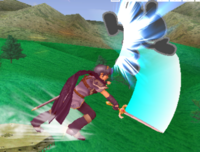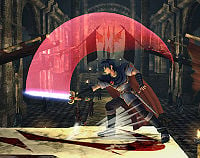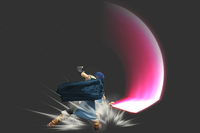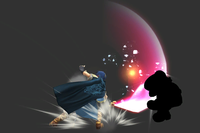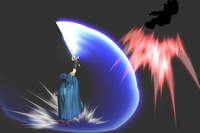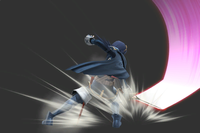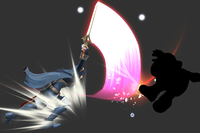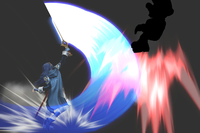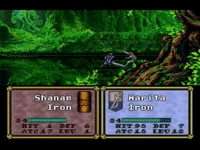Dancing Blade
- For other pages with the name Blade, see Blade (disambiguation).
| Dancing Blade | |
|---|---|
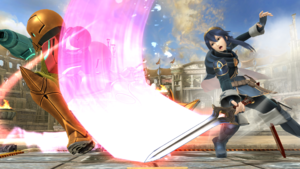 The final strike of Lucina's Dancing Blade tilted forward in Smash 4. | |
| User | Marth Lucina |
| Universe | Fire Emblem |
| “ | A combo that you can change by sliding |
” |
| —Smash for 3DS's foldout | ||
Dancing Blade (マーベラスコンビネーション, Marvelous Combination) is Marth and Lucina's side special move.
When used, Marth/Lucina performs a sideways slash, which can be followed by up to three more hits with further presses of the special button. Tilting the control stick in a specific direction during the execution of any slash but the first changes its trajectory and properties: the second hit can be tilted forward or up, while the third and fourth hit can be tilted up, forward or down. Counting all hits, there is a total of 18 possible combinations.
Roy's Double-Edge Dance is a variant of this attack, which also shares the same Japanese name.
In Super Smash Bros. Melee
In Melee, the first attack is often used to gain horizontal recovery. Also, Marth will glow a color as he uses his attacks. For the first attack, he will glow red; the second, green; the third, blue; and for the last one, red again. It is quite unlikely that Marth would have to use all four attacks, since both the third and fourth strikes have much higher knockback than the first and second. It is rather difficult to pull off the full attack, as the attack requires timing on each blow to follow up.
In Super Smash Bros. Brawl
Dancing Blade has seen quite a few changes since Melee. Unlike in Melee, Marth doesn't glow anymore when using this attack: the attacks simply change the motion trail of his sword. The colors are more coordinated, with Red always representing neutral, Blue always representing up, and Green always representing down. Secondly, the timing no longer matters, so it can be performed easily. If the first hit connects, it is nearly impossible to escape the rest of the combo when the timing is fast enough. The knockback on the third strike is decreased, allowing for better combos. The final can either be 2 KO moves at high percentages (Up can KO at 118% tipped, 142% base. Forward can KO at 140% tipped, 179% base) or a quick damage racker (Down can KO at 213% tipped, 305% base), while the upward final strike has a brand new animation (a turning upward flick as opposed to a turning slam-slash in Melee).
The third hit is still a meteor smash, but only if not sweetspotted. However, the move aids Marth's recovery less than the previous game. The damages for the first hit is 3% (4% tipped), both the second hits are also 3% (4% tipped), all the third hits are 4% (5% tipped) and the last up and forward hits are both 6% (8% tipped) while the total of the multiple down hits are 11% (13% tipped).
Reverse Dancing Blade
In Brawl, Marth's Dancing Blade can be reversed by tapping the control stick in the opposite direction a few frames after the side special move has been activated. There is no increase to damage, knockback and has no reverse animation, this makes reversing only useful if it is used to attack behind Marth. Although since Dancing Blade is so quick, it looks like there is a slight animation of Marth turning around, it is actually the start of the animation of a normal Dancing Blade that continues on the other side when Marth turns around.
In Super Smash Bros. 4
Dancing Blade returns in Super Smash Bros. 4 as Marth's side special move, as well as that of his clone, Lucina. Visually, the tip of the sword in Marth's version glows more brightly than the rest of the trail, while Lucina's is a full bright white blur all along her blade. The attack generally deals more damage when angled downwards, but has more ending lag, and the third hit downwards no longer meteor smashes. Additionally, it is much easier to escape out of, due to the move's lowered hitstun, less interruptibility, and its tendency to throw opponents out of the move even if the first hit connects. Overall, the move is now less effective than in Brawl, although the changes to the move's knockback angles in the 1.1.3 update made the attack easier to chain together, making it more effective than how it was initially.
Customization
Special Move customization was added in Super Smash Bros. 4. These are the variations:
| 1. Dancing Blade | 2. Effortless Blade | 3. Heavy Blade |
|---|---|---|
| "Press repeatedly to unleash a sword combo. Press up or down to change the attacks." | "You can't change the combo type, but you can wait longer between attacks. Lower damage." | "Each strike is stronger but launches foes, making it hard to pull off a combo." |
| 1. Dancing Blade | 2. Effortless Blade | 3. Heavy Blade |
|---|---|---|
| "Attack up to four times. Press up or down to change the combo type." | "You can't change the combo type, but you can wait longer between attacks. Lower damage." | "Each strike is stronger but launches foes, making it hard to pull off a combo." |
- Dancing Blade: Default.
- Effortless Blade: Expands window for button input, but only allows forward swings while dealing less damage and knockback.
- In Super Smash Bros. for Nintendo 3DS, this variation is a Challenge unlock, only obtainable by clearing 100-Man Smash in less than 3 minutes.
- Heavy Blade: Deals much more damage and knockback, and the slashes have more range; the first swing has enough knockback to be a viable KO move, and the final swings are all capable of KOing at very low percentages. However, the input timing is more strict while the hits are slower, with the resultant increase in knockback also making each separate hit almost impossible to link together.
Origin
Dancing Blade loosely resembles the Astra skill, which allows its users to unleash five consecutive blows upon an enemy when activated. Astra does not exist in any of Marth's four native games, as the skill system debuted in Fire Emblem: Genealogy of the Holy War after Marth's original two games and was not included in the Nintendo DS remakes, but Marth's "King Marth" bonus unit incarnation in Fire Emblem Awakening does indeed possess Astra as a default skill. Lucina is also able to obtain Astra through reclassing if her mother is a female Avatar, Sully, or Olivia in the save file in question. In their default classes in Awakening, Lord and Lodestar respectively, Lucina and Marth's motions while using it are a strong visual parallel to the Dancing Blade motions in the Smash Bros. series.
The English version of Fire Emblem Fates went on to give the amiibo incarnation of Marth and his Lodestar class a skill named Dancing Blade after the Super Smash Bros. move; however, it has a different Japanese name ("Gentle Blade") and an unrelated effect, granting the user +3 to their Speed stat but -1 to their Defense stat.
Gallery
Lucina attacking Link with the final downward hit of Dancing Blade.
Trivia
- By repeatedly using the first attack of Dancing Blade, Marth can rise into the air during a Tiny, Light Special Brawl or in the Flying transformation of Pokémon Stadium 2.
- Falling off a conveyor belt while using the first, the third or the forward version of the fourth attack gives Marth great horizontal acceleration. The attack that makes him fastest is the up version of the third attack. Note that this works not only for Marth, but is most noticeable with him.
- Marth is unable to do any other hits than the first slash when having too much sideways momentum in the air.
- Like Dolphin Slash, the sound of Dancing Blade varies between versions, except that the differences are less apart from each other. Brawl's version includes loud slash sound effects while the Smash 4 version is significantly quieter.
- In Smash 4, the third hit of an aerial Dancing Blade aimed upward or downwards will use their Melee animations (swinging downwards for the former, and a downward stab with a twirl for the latter), despite the move being given new animations for their grounded versions.
